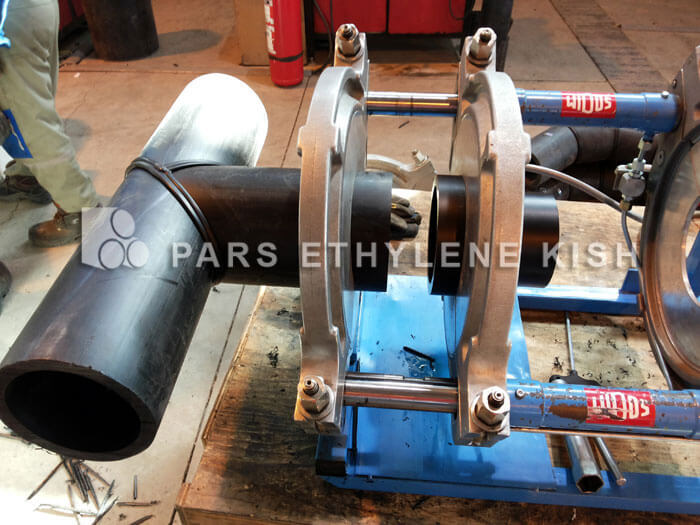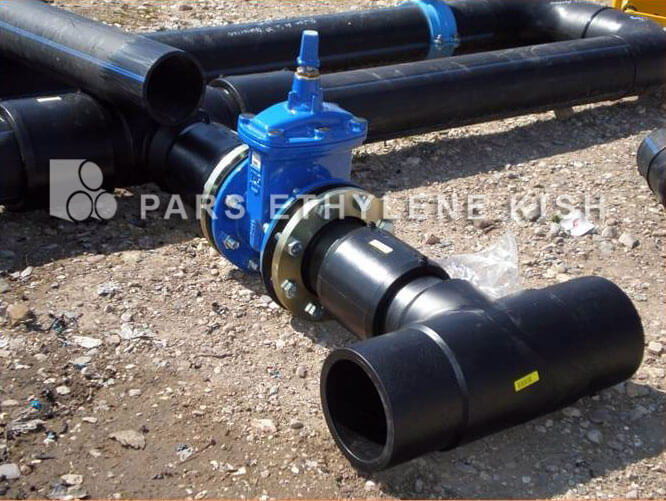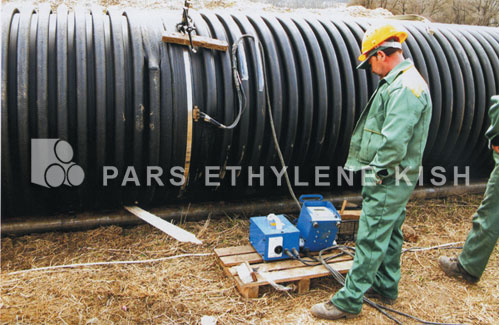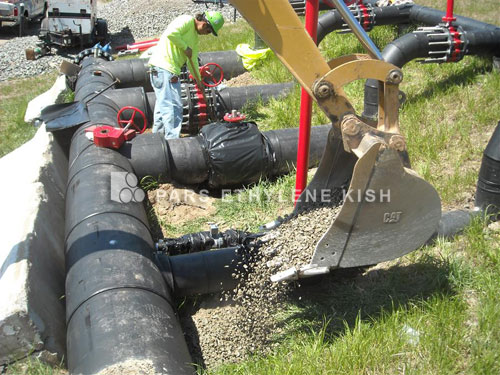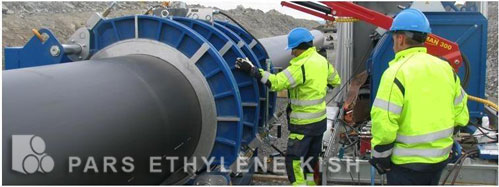
HDPE Pipe Fittings
The HDPE pipe fittings can be performed in several ways as described below. It should be noted that based on the type of the fittings included in the specifications of the design one should do pipe fittings in different parts of the plan.
HDPE pipes are usually produced with two simple ends. Therefore, in order to establish a connection between the two branches, it is necessary to connect one simple end of a branch to the other simple end with a connection to each other. The various methods used to connect HDPE pipes, accessories and valves, are as follows:
1- Thermal Butt (Butt fusion)
2- Thermal bushing
3- Electro Fusion
4- Flange
5- Extrusion
6- Bolting
7- Rubber gasket latching
It should be explained that all of the above methods are currently not applicable due to the lack of production of the necessary supplies in the country, but the explanations needed to use them, if produced, are given. The consultant engineer will determine the pipe connection method according to the facilities available at the time of work in the specifications of the design. At the moment, the butt thermal connection is used for the main projects of HDPE piping and the flange connection is used for special fittings. The contractor is required to provide arrangements, and qualified personnel for any method specified in the layout specifications, and, accordingly, proceed with the connection.
HDPE Pipe Fittings
HDPE Pipe Fittings Adaptable for all piping, these fittings are used on HDPE pipe to change direction, insert a lateral or tee, or simply to cap off an end of a line.
polyethylene pipe fittings
polyethylene pipe fittings are used in all polyethylene pipelines and projects that have been used in some way as polyethylene tubes, and the type of polyethylene pipe fittings will vary according to the type of project. Polyethylene pipes are used in sewage transfer, water supply, fire extinguishing systems, covering cable and gas applications, which will vary depending on polyethylene pipe applications.
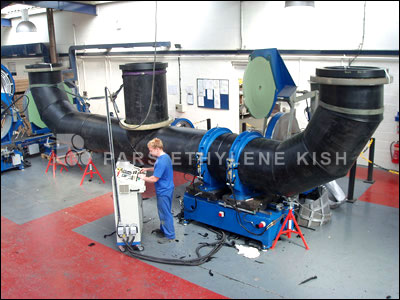
Butt fusion
In the butt fusion of HDPE pipes, a special fusion device is used. In this device, you need to place the two branches of the pipe in the same direction. The pipes should be completely clean and free of waste. If the pipe is unshaped from the full circle, tighten the clips on both sides of the pipe. For better fusion, it is necessary to have a double-head straightening machine with the device and the two ends of the pipe to be completely flat and free of defects. Then the two ends of the pipe are placed opposite each other to ensure the apparent lack of a gap between them. The maximum tolerance outside the pipe is one millimeter for pipes up to 315 mm in diameter and two mm in diameter for larger diameters.
After these preparations, the contractor must place a special metal plate containing a heater element between the two simple pipes’ ends and bring the pipes ends to the metal plate gradually, so that the ends melt. Before connecting to power, it's important to be careful that the metal plate is completely clean. After the end of the pipes has melted enough, it is necessary to remove the plate from the pipes, and within a maximum of 10 seconds, the pipes should move slowly and sufficiently to each other to stick together for the melting section of the pipe ends integrate into one piece and a solid connection establishes.
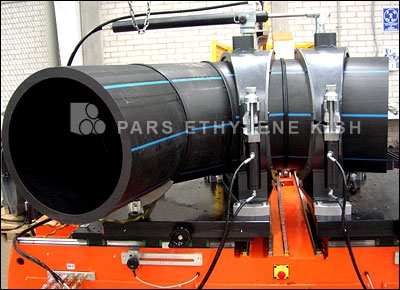
As long as the heater plate is between the ends of the pipe and the edge of the Polyethylene pipes are melting, the two branches of the pipe must not be driven or shaken to each other. These actions lead to a deformation of the pipes that are relatively soft due to the heat. The extruded side of the melting pipe must be about 2 to 3 mm before connecting. After the pipe's ends have melted enough, it is necessary to remove the pipes from the plate, and within a maximum of 10 seconds, the pipes should move slowly and sufficiently to each other to stick together for the melting section of the pipe ends integrate into one piece and a solid connection establishes.
The contractor's attention is drawn to the fact that the force of moving the pipes towards each other is effective in the degree of bond strength. Pulling pipes with high force may cause all melt materials to be extruded from the joint and the relatively cold part of the pipes connect to each other. Also, driving the pipes with low force makes the pipes connect to the narrow edge, which, in both cases, will not fit properly and firmly. This connection should be maintained for a minimum of 5 to 10 minutes without moving, until the connection is completely cooled and the temperature reaches ambient temperature.
If the melting material adheres to two metal plates, the contractor must stop the bonding operation and repeat the operation after cleaning the plates and cutting the melting areas.
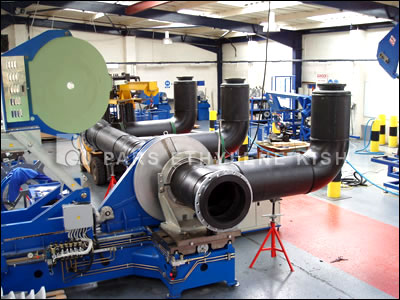
The butt fusion of HDPE pipes should not be carried out inside the trench. The fairly large length of some pipes that is fused outside the trench will provide sufficient flexibility, using it one can put part of it inside the trench and attach its end to the outside of the other branches. In order to perform correct fusion, it is imperative that the following principles and criteria are observed by the contractor:
- Pipes of different thicknesses should not be fused together.
- The flatted edges of the pipe ends should not be in contact with the hand after being chipped.
- Clean the cuts and particles from inside the pipe and onto the device.
- The device should not be wet, dirty and dusty.
- Do not expel pipes from the device before fully cooling the connection.
- Use qualified people.
- Due to the fact that for any specific type of HDPE material, there is a certain range for the main parameters of fusion, including temperature, edge pressure and cooling time, before any fusion of HDPE, the manufacturer of the pipe should be inquired for and the relevant personnel should be trained for implementation, by the pipe manufacturer or the manufacturer of the fusion device.
- If a connection between two types of HDPE pipes, pipes or related fittings is required, the fusion method must be sought from both manufacturers.
- In the case of rainy weather, extreme winds and cold, avoid fusion. In case of necessity, the tent should be used, and in any case, the working environment temperature should not be below 0 degrees Celsius in any case.
In addition, the contractor must provide the proper tools for performing butt fusion. As a guide, at least the required equipment and machinery are as follows:
- A generator to provide thermal energy of the iron plate, shredder and hydraulic pumps to provide the desired pressure.
- The fusion machine should be equipped with appropriate clamps and timers.
- Clamps for fixing the two sides of the iron.
- Napkin to clean the iron plate.
- Tools for cutting the extruded edges of the pipe from inside and outside.
- Measurer the extruded part of the pipe.
- Thermometer for measuring the surface temperature of the iron.
- Pipe cutting tool.
- Thermometer for measuring air temperature.
- Timer
Bushing fittings
For this type of connection, the necessary accessories and couplings must be provided. These types of connections are currently very limited and are used in low diameters. In this method, a part of the pipe enters the bush. The connection inside the bush is heated by a special device simultaneously with the outer surface of the pipe. After a period of time appropriate to the pipe diameter and determined by the manufacturer, the heat transfer device is removed and the pipe is immediately inserted into the receptacle. Then, the connection enters it without any force until it is completely cool.
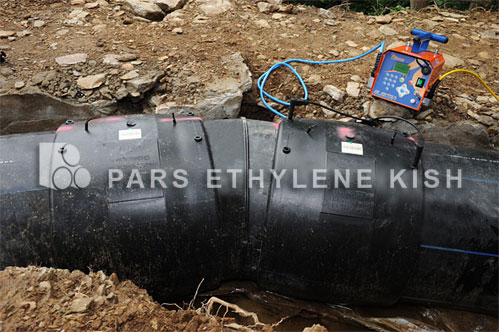
Electrofusion Fittings
This type of connection is the most reliable ways of connecting HDPE pipes. In this connection, all accessories and fittings in HDPE pipe couplings bowl or accessories are equipped with an electric heating coil. By heating coils, adjacent materials begin melting and increasing the melting range and reaching the pipe wall, the outer surface of the pipe melts. Due the interaction between molecules, the pipe will hit the bowl.
Full integration and proper connection with the electrical method occurs if:
- the heating coil is located as close as possible to the contact surfaces.
- the coil is wrapped around the bowl carefully with appropriate intervals.
- the heat spreads uniformly during welding.
- temperature and pressure of the melted section is carefully controlled.
- damage to the coil is prevented.
- protection before, during and after the connection is observed.
- the right time for electrofusion is considered.
Subject to the foregoing, the points we need to consider in this connection, are as follows:
- Cut the pipe perpendicular to the axis, sand the coarse parts and clean the pipe ends.
- Clean any debris from the pipe.
- Mark the notches based on the size of the coupling bowl of the pipe.
- Scrape the pipe to the location marked using appropriate means. Scratching or unsmoothing pipes will not be enough.
- Prepare the fittings in place and check the bowl in terms of the cleanliness.
- Clean the scraped part with appropriate materials (iso-propanol).
- Place the two simple ends of the pipe placed inside couplings or accessories, so that the two pipes are in content with the central appendix.
- For a connection of this type, the use of clamps, for the maintenance of the connection is necessary.
- Remove the protecting part of the electrical connector terminals from the coupling or accessories.
- Connect the electrical control system to these terminals.
- With respect to electrical characteristics required in terms of voltage and fusion time, controls should be conducted.
- Note that the system representing the melting shows the exact situation.
- The connection system should remain in the clamp for full attachment.
Flange connection
Flange connection is used for connecting HDPE pipes to cast iron or galvanized steel or valves and appurtenances.
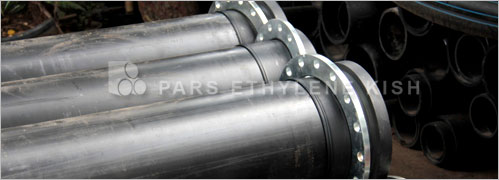
This connection is composed of an HDPE conversion, one end of which is flanged and the other end is simple and of a perforated metal ring. The diameter of the holes in the ring, must be in accordance with the standard of flange pipes or valves used. Complete details about this type of connection, are provided in the properties described for HDPE pipes.
To make the connections, the perforated metal ring must be placed on the simple end that is connected to the flange, and then, the simple end of the conversion is fused to the simple end of the HDPE ( hdpe pipe flange ). Pipes must be driven in one direction. After completing fusion, the perforated metal ring should be pushed into the flange so the flange holes are against each other. The flange can be connected to each other by bolts and nuts. By twisting the nuts the HDPE conversion flange could be fully pressed to the flange of valves or accessories to provide the necessary seal.
Bolting
Mechanical fittings for HDPE pipes are usually made up of three pieces. Closing the nuts to the midsection and twist it, the connection is established. An intermediate piece with two wound sides and two pieces on each side, in the form of nuts, and the simple end of the pipe that are to be connected, are inserted into the nuts. By connecting the nuts to the intermediate piece and twisting it, the connection is established.
Usually this type of a mechanical connection is used for soft PE pipes (hoses). The pipe is soft and can be dragged onto the midsection, and by winding the nut, the soft end of the pipe and the midsection are compressed and sealing is established. In order to make this type of fitting suitable for PE pipes, in addition to the three above-mentioned parts, it is necessary, that the conical shaped gaskets are also used to fit between the body of the nut and the end of the Pipe, due to the strengthening of the nut, the middle piece is compressed and sealing is established.

Due to the fact that the outer diameter of the HDPE pipes with a certain tolerance should be appropriate for the diameter of the internal thread of the nut, and because in the hard HDPE pipes, the thickness of the wall of the pipes of different factories is not necessarily the same, so if it is intended to connect the pipes from the twisted pair to be used, this type of connection should be made by the manufacturer of the pipes, so that the connection can be made. Typically, this type of connection is produced for small diameter Pipes. Therefore, it is practically not used in the main water supply pipes. This type of connection is not suitable for water distribution pipelines, which are mostly buried.
Extrusion
It is used for connecting pipes with a thick wall. However, its consumption is very limited and can be verified by the pipe manufacturer. In this type of connection, it is heated by a flame, the end of the two Pipes or pipes and the connection, and then, by another, the molten material of the polyethylene is injected between the two ends of the Pipe.
Rubber gasket
This method can also be done if the pipe manufacturer manufactures its own bowl and welds it to the pipe. The sealing of two pipes or fittings is provided by a rubber gasket.
HDPE Pipe manufacturers
Due to the limited production of PE pipes in terms of work pressure, diameter, accessories, connection type and production capacity, it is necessary to identify these constraints and adapt to the requirements of the design before making the pipe selection certainty.
For more information and download the catalogues visite HDPE Fittings Catalogue page
